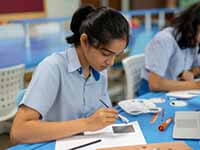Education has leaped to new highs in the 21st century – both in terms of syllabus and delivery of the syllabus. With the advent of new-age learning techniques, schools need to incorporate them into everyday teaching.
A 21st century learner is someone who is not just familiar with the latest technology but is capable and competent in gathering useful information using digital resources. They are likely to have a strong interest in current events and social issues with a high awareness of global perspectives and cultural diversity.
Schools that cater to Generation Alpha and above, must have specially designed, dedicated facilities that evoke rich learning experiences and create higher levels of engagement among students for deeper benefit.
What do dedicated spaces imply in the context of primary schools?
Experts insist on imbibing the four core values of collaboration, communication, creativity and critical-thinking among students from a young age. These 4Cs – when weaved into the school curriculum through fun and interactive spaces – give students bigger avenues to explore and innovate, as well as deeper knowledge of things learnt on a daily basis.
Schools that provide great facilities in the form of dedicated spaces for these activities reap richer benefits for their students.
Such spaces imply exclusive areas in the school premise that help the students learn beyond the four walls of the classroom. They offer tools and platforms to cultivate 21st century skills among primary school students beyond the confines of a traditional classroom.
Let’s see how dedicated spaces and custom-designed facilities at primary school foster the 4Cs of 21st century learning among students:
Dedicated spaces for Collaboration
Collaboration is one of the soft-skills that students must learn in order to prepare themselves for the future. Traditional classrooms foster only limited collaboration under the supervision of teachers. However, new age collaboration requires independent team-work and a flexible environment where students can freely interact and brainstorm with peers.
Dedicated spaces like Student Lounges and Learning Commons or unique learning spaces between two classes at GIIS are great examples that facilitate collaboration. Primary students are often seen using these facilities to work together on assignments and brainstorm on team projects. Equipped with TV screens, and wifi facilities, the classrooms and the campus enable students to research online, and reach out to experts at the click of a button when necessary.
Also read: How do Smart Schools lead to better learning outcomes?
Dedicated spaces for Creativity
Creativity is definitely one of THE most important criteria for student development and success. Primary schools have a role to play in ensuring that students tap into their creativity, be innovative and give shape to their ideas to be better learners.
Through spaces like Maker space, Design Studios and various art, dance and music studios, primary schools provide a platform for students to explore their creativity and come up with newer solutions to age old problems.
At GIIS, these dedicated spaces expand from science to art. Graphic Design Studio, Ceramic Studio, Art and Music Studios, Design Thinking labs, Culinary studio and more are available for students to explore and expand their skills.
Additionally the school has programmes like Real World Challenges Convention where students are given a stage to present their new ideas, and winning entries receive recognition and awards.
One such effort was the Hunger Warriors – a student group which was recognised by the United Nations for their project on reducing world hunger through collective effort.
“Personally, it was a very enriching experience. I speak on behalf of my team members that we are grateful for the opportunity and support provided by our teachers, students and well-wishers all around. Every time we had the opportunity to help someone, the joy knew no bounds. Every instance I can help someone is memorable,” said Jaidev Balaji, GIIS IB Yr 1 student, leading the Hunger Warriors initiative that got recognition from the United Nations.
Dedicated spaces for Communication
Generation Z, now followed by their younger counterparts, Generation Alpha – are natural communicators. They are at ease on social platforms like Instagram and Tik Tok, where they post videos of their creations without hesitation.
Such inherent inclination towards communication needs proper channeling, and primary schools play a large part in such an endeavour. New age communication skills go beyond writing, speaking and listening skills.
A 21st century school must have facilities that focus on developing the confidence of students in using various channels of communication.
Radio Studio, TV Studio and Language Labs at GIIS are some of the new age facilities that take training in communication to the next level and help primary grade students learn communication beyond the realms of creative writing and public speaking.
Projects like Virtual Filmmaking and Jockeying for school podcasts are some of the avenues GIIS provides to bring out the communicator in students. Many have contributed through vlogs and participated in online culinary shows, which has won them accolades.
Dedicated spaces for Critical-thinking
With strong emphasis on developing critical-thinking as one of the key 21st century skills among students, primary schools must be equipped with dedicated facilities that foster problem-solving skills among students. To be critical-thinkers, students need to relate concepts to the world outside the classroom.
At GIIS, facilities like Environment Lab, IT Lab, coding workshops and Robotics workshops help students apply the concepts learnt in class to real-world situations. Through their own inclinations and with the help of mentors and teachers, students have made projects like Self-Watering Plants, Ocean cleaners and Anti-Dengue kits.
Going hands-on is the best way to learn a skill and develop critical thinking. Primary schools should expose students to multiple areas where they can come across challenging concepts and hone their problem solving skills.
An engaging ambience for 21st century learners is not just an extra addition but a core necessity where students will thrive and grow. Primary schools should have dedicated facilities that offer them a NextGen learning experience, promote peer-to-peer collaboration, and widen the learning from the confines of the classroom to the entire school premises.
If you are keen to know more about GIIS, please do not hesitate to book a campus tour today.

































